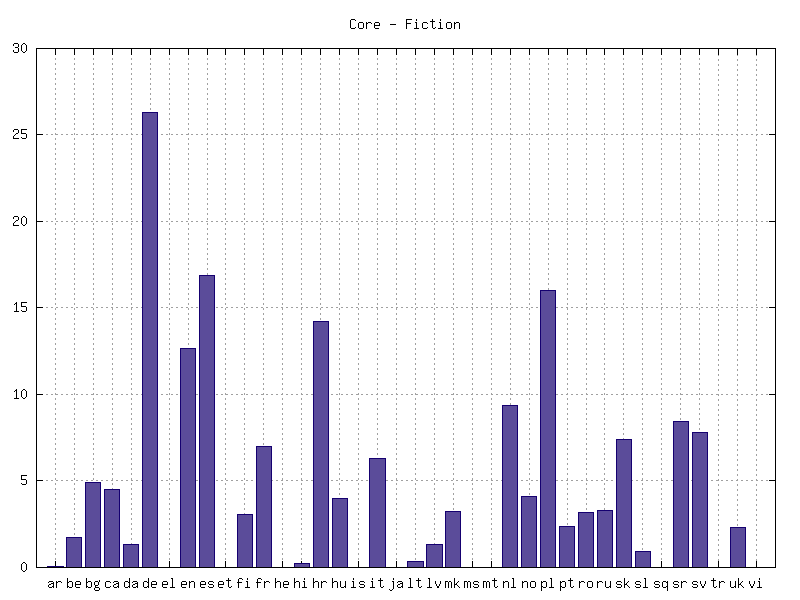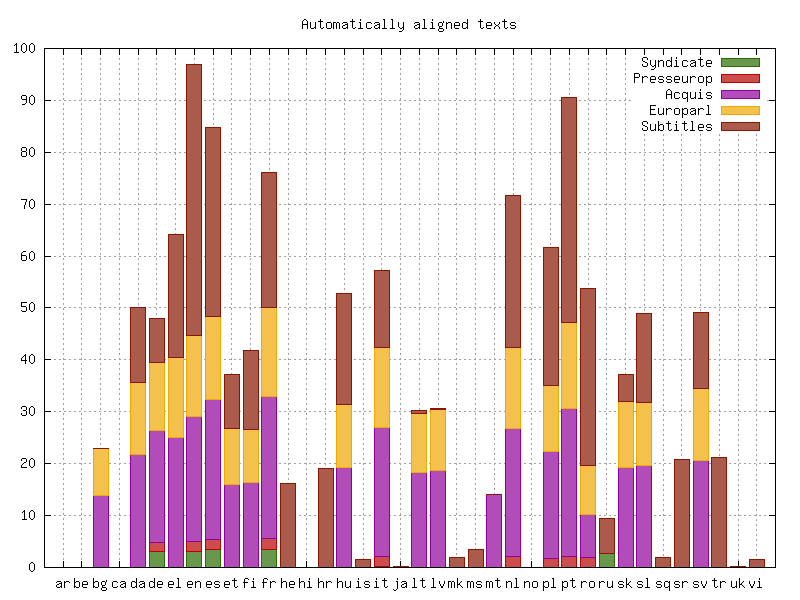InterCorp: Release 7
| Name | Czech – core | Czech – collections | other – core | other – collections | |
|---|---|---|---|---|---|
| Positions | Number of tokens | 95 814 527 | 116 374 744 | 208 845 922 | 1 546 493 833 |
| Number of word forms | 77 121 760 | 88 303 155 | 173 224 560 | 1 216 880 655 | |
| Structural attributes | Number of documents | 1 184 | 5 | 2 294 | 87 |
| Number of div | 1 184 | 107 388 | 2 294 | 1 817 043 | |
| Number of sentences | 6 595 174 | 13 497 188 | 12 796 035 | 142 788 867 | |
| Further information | reference | YES | |||
| representative | NO | ||||
| publication date | 2014 | ||||
| foreign languages | 38 | ||||
| tagged languages | 20 | ||||
| lemmatized languages | 17 | ||||
InterCorp is a large parallel synchronic corpus covering a number of languages. The corpus is compiled mostly by teachers and students of the Faculty of Arts, Charles University in Prague, and by other collaborators of the ICNC.
Access to the texts
After registration the corpus can be searched using a web interface. The registration is valid for all ICNC corpora with public access. If you already have a user name and password for the Czech part of the Czech National Corpus, you do not need to register for the parallel corpus.
InterCorp can be accessed via a standard web browser from the integrated search interface of the Czech National Corpus KonText. A tutorial is available in Czech and a brief summary also in English.
After signing a non-profit licence agreement, texts from InterCorp can also be acquired as bilingual files including shuffled pairs of sentences. Please contact us at the address below if you are interested.
New release of InterCorp is published mostly each year. With each new release, its size, possibly also the number of languages and the extent and quality of annotation may grow. Previous versions remain available (in Park starting from release 5, in the other interfaces from release 6).
References
In results of your work based on InterCorp we would appreciate a link to the project site www.korpus.cz/intercorp. You might also consider adding the following reference in your scientific publications: Čermák, F. and Rosen, A. (2012). The case of InterCorp, a multilingual parallel corpus. International Journal of Corpus Linguistics, 13(3):411–427 (bibtex1), electronic edition at //ing entaConnect//, preprint version).
For more references see here. or in the repository of bibliographical items based on the CNC. All references to work using InterCorp is welcome. See here for details.
Texts in the corpus
The core of InterCorp consists mostly of fiction, manually aligned. Intercorp offers also a selection of fully automatically processed texts, so-called collections. The choice in the present release 7 includes:
These texts have been aligned automatically: search results may include a higher number of misaligned segments. Morevore, the collections do not retain all texts from the original resource. This includes texts that have no Czech counterpart. Some texts from the Acquis Communautaire and Europarl corpora have been partially corrected or omitted – as a result, they may differ in form or size if compared with the original source. A similar selection was applied to the Open Subtitles database, where – as an additional reduction – only a single translation was selected per title and language. On the other hand, some metadata items missing in the original resource but detectable from context or other sources, have been added.
Each text has a Czech counterpart. As a result, Czech is the pivot language: for every text there is a single Czech version (original or translation), aligned with one or more foreign-language versions. The total size of the available part of InterCorp in release 6 from April 2013 is 138,779,000 words in the aligned foreign language texts in the core part and 728,508,000 in the collections (see Version history). The share of the core and the collections in the corpus can be seen in the following chart. The size is shown in millions of words.
Corpus size in thousands of words
| Language Code | Language | Core | Syndicate | Presseurop | Acquis | Europarl | Subtitles | Total |
|---|---|---|---|---|---|---|---|---|
| ar | Arabic | 34 | 0 | 0 | 0 | 0 | 0 | 34 |
| be | Belarusian | 1,751 | 0 | 0 | 0 | 0 | 0 | 1,751 |
| bg | Bulgarian | 4,923 | 0 | 0 | 13,816 | 9,083 | 0 | 27,823 |
| ca | Catalan | 4,498 | 0 | 0 | 0 | 0 | 0 | 4,498 |
| da | Danish | 1,311 | 0 | 0 | 21,680 | 13,916 | 14,430 | 51,336 |
| de | German | 26,315 | 3,050 | 1,715 | 21,724 | 13,089 | 8,367 | 74,260 |
| el | Greek | 0 | 0 | 0 | 25,070 | 15,404 | 23,715 | 64,188 |
| en | English | 12,641 | 3,083 | 1,863 | 24,208 | 15,580 | 52,101 | 109,476 |
| es | Spanish | 16,907 | 3,479 | 1,948 | 27,001 | 15,885 | 36,379 | 101,599 |
| et | Estonian | 0 | 0 | 0 | 15,963 | 10,900 | 10,296 | 37,158 |
| fi | Finnish | 3,054 | 0 | 0 | 16,455 | 10,175 | 15,098 | 44,782 |
| fr | French | 6,976 | 3,535 | 2,054 | 27,352 | 17,178 | 25,962 | 83,057 |
| he | Hebrew | 0 | 0 | 0 | 0 | 0 | 16,221 | 16,221 |
| hi | Hindi | 206 | 0 | 0 | 0 | 0 | 0 | 206 |
| hr | Croatian | 14,210 | 0 | 0 | 0 | 0 | 19,093 | 33,303 |
| hu | Hungarian | 4,014 | 0 | 0 | 19,177 | 12,307 | 21,240 | 56,737 |
| is | Icelandic | 0 | 0 | 0 | 0 | 0 | 1,585 | 1,585 |
| it | Italian | 6,313 | 247 | 1,893 | 24,849 | 15,489 | 14,654 | 63,446 |
| ja | Japanese | 0 | 0 | 0 | 0 | 0 | 113 | 113 |
| lt | Lithuanian | 358 | 0 | 0 | 18,393 | 11,213 | 558 | 30,522 |
| lv | Latvian | 1,337 | 0 | 0 | 18,745 | 11,689 | 280 | 32,051 |
| mk | Macedonian | 3,221 | 0 | 0 | 0 | 0 | 1,877 | 5,098 |
| ms | Malay | 0 | 0 | 0 | 0 | 0 | 3,521 | 3,521 |
| mt | Maltese | 0 | 0 | 0 | 14,133 | 0 | 0 | 14,133 |
| nl | Dutch | 9,370 | 0 | 2,082 | 24,746 | 15,563 | 29,363 | 81,125 |
| no | Norwegian | 4,103 | 0 | 0 | 0 | 0 | 0 | 4,103 |
| pl | Polish | 16,009 | 0 | 1,662 | 20,628 | 12,811 | 26,572 | 77,683 |
| pt | Portuguese | 2,393 | 0 | 2,103 | 28,603 | 16,485 | 43,392 | 92,976 |
| ro | Romanian | 3,156 | 0 | 1,917 | 8,200 | 9,446 | 34,129 | 56,847 |
| ru | Russian | 3,308 | 2,651 | 0 | 0 | 0 | 6,886 | 12,844 |
| sk | Slovak | 7,402 | 0 | 0 | 19,223 | 12,734 | 5,134 | 44,493 |
| sl | Slovene | 900 | 0 | 0 | 19,646 | 12,241 | 17,025 | 49,811 |
| sq | Albanian | 0 | 0 | 0 | 0 | 0 | 2,004 | 2,004 |
| sr | Serbian | 8,413 | 0 | 0 | 0 | 0 | 20,777 | 29,189 |
| sv | Swedish | 7,789 | 0 | 0 | 20,586 | 13,840 | 14,694 | 56,909 |
| tr | Turkish | 0 | 0 | 0 | 0 | 0 | 21,191 | 21,191 |
| uk | Ukrainian | 2,310 | 0 | 0 | 0 | 0 | 246 | 2,556 |
| vi | Vietnamese | 0 | 0 | 0 | 0 | 0 | 1,474 | 1,474 |
| Subtotal | 173,225 | 16,044 | 17,239 | 430,195 | 265,029 | 488,373 | 1,390,105 | |
| cs | Czech | 77,122 | 2,749 | 1,640 | 20,303 | 12,923 | 50,688 | 165,425 |
| Total | 250,346 | 18,793 | 18,880 | 450,498 | 277,952 | 539,061 | 1,555,530 |
N.B.: Each Czech text is counted only once, even though it may have more than one foreign counterpart.
Morphosyntactic annotation
Texts in the following languages have received some morphosyntactic annotation.
| Language | Tags | Lemmas | Brief description | Detailed description | Tool |
| Bulgarian | ✔ | in English | TreeTagger | ||
| Czech | ✔ | ✔ | in Czech in English2) | in English | Morče |
| Dutch | ✔ | in Dutch | TreeTagger | ||
| English | ✔ | ✔ | in English | in English + additions | TreeTagger |
| Estonian | ✔ | ✔ | in Estonian and English | TreeTagger | |
| Finnish | ✔ | ✔ | in English3) | OMorFi+HunPOS | |
| French | ✔ | ✔ | in English | TreeTagger | |
| German | ✔ | ✔ | in English4) | in German | RFTagger |
| Hungarian | ✔ | in English | HunPos | ||
| Icelandic | ✔ | ✔ | IceStagger | ||
| Italian | ✔ | ✔ | in English | TreeTagger | |
| Lithuanian | ✔ | ✔ | in Czech and English | in English | Author: Vidas Daudaravičius |
| Norwegian | ✔ | ✔ | in English in Norwegian | analyzer, tagger | |
| Polish | ✔ | ✔ | in English in Polish | in English | Morfeusz, TaKIPI |
| Portuguese | ✔ | ✔ | Spanish | TreeTagger | |
| Russian | ✔ | ✔ | in English | in English5) | TreeTagger |
| Slovak | ✔ | ✔ | in Slovak | in Slovak | Radovan Garabík, Morče |
| Slovene | ✔ | ✔ | English | totale | |
| Spanish | ✔ | ✔ | in English | TreeTagger | |
| Swedish | ✔ | ✔ | Stagger |
See Park Manual for advice on the use of tags in queries.
Problems, comments, suggestions
… on the content of the corpus and on the search interfaces are welcome at
Acknowledgements
We are grateful for the possibility to use the following texts and software:
Texts:
- Fiction in many Slavic and some other languages from ASPAC – Amsterdam Slavic Parallel Aligned Corpus – with special thanks to Adrian Barentsen
- Newspaper texts in a number of languages from the Presseurop/VoxEurop server
- Legal texts in EU languages from the JRC-ACQUIS corpus
- Proceedings of the European Parliament from the EuroParl corpus
- Slovak-Czech concordances from the Slovak National Corpus
- Short stories in a number of languages My 1989 from Goethe Institut
- A number of texts in the Czech-Lithuanian section of the corpus and Jiří Levý's The Art of Translation in more languages – with special thanks to Patrick Corness
- George Orwell's novel 1984 in a number of languages from the Multext-East corpus
- Ukrainian and Polish texts from the PolUkr corpus
- Film subtitles from the database Open Subtitles
Pre-processing
- parallel text editor InterText by Pavel Vondřička
- Aligner Hunalign
- Sentence splitter for Czech by Pavel Květoň
- Sentence splitter for Norwegian by Jarle Ebeling and Pavel Vondřička
- Sentence splitter Punkt for all other languages from Natural Language Toolkit
Taggers/lemmatizers:
- TreeTagger for Bulgarian, Dutch, English, Estonian (thanks to Helmut Schmid), French, Italian, Portuguese (thanks to Pablo Gamallo), Russian and Spanish
- HunPOS for Hungarian and other languages
- Tagger for Slovak (thanks to Radovan Garabík)
- Tagger for Lithuanian (thanks to Vidas Daudaravičius and Hana Skoumalová)
- Tagger for Norwegian (thanks to Pavel Vondřička)
- totale for Slovene (thanks to Tomaž Erjavec)
- RFTagger for German
- OMorFi+HunPOS for Finnish (thanks to Filip Ginter)
- Stagger and IceStagger for Swedish and Icelandic (thanks to Robert Östling)
Corpus Query Engine:
Last update: 19 December 2014
See also
@article{cermak:rosen:10, Author = {Franti{\v{s}}ek {\v{C}}erm{\'{a}}k and Alexandr Rosen}, Issn = {1384-6655}, Journal = {International Journal of Corpus Linguistics}, Number = {3}, Pages = {411–427}, Title = {The Case of {I}nter{C}orp, a multilingual parallel corpus}, Url = {http://utkl.ff.cuni.cz/~rosen/public/2012_intercorp_ijcl.pdf}, Volume = {13}, Year = {2012}}









